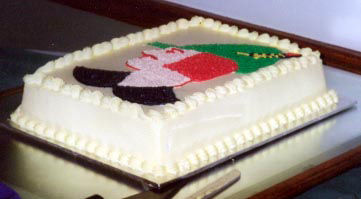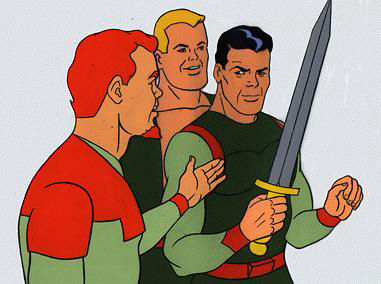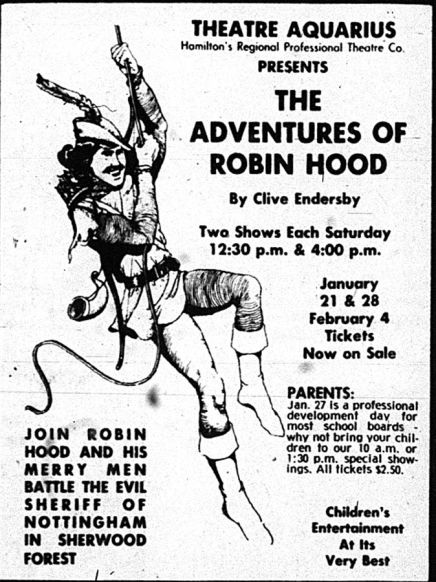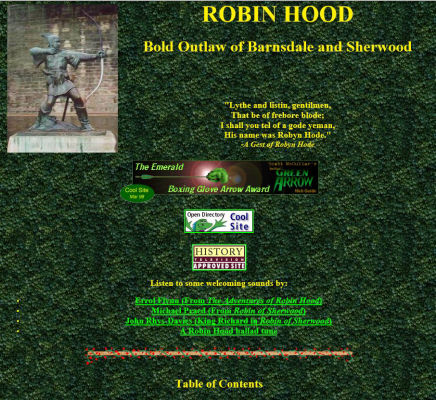Robin Hood and adulthood
My interest in the Robin Hood legend never really went away after that. And over the years, I read Robin Hood novels and saw films (including the Errol Flynn film - properly this time - although I didn't truly appreciate it until I had left adolescence well behind.)
Also, I've tried my hand at some Robin Hood fiction, including an abortive attempt at a novel, which I still might get back to someday. And when I first went to England after university, Nottingham and Sherwood Forest were among my destinations. You can read about that in the section that follows.
And then I created this website. Back in the long ago days of late 1996 and early 1997 when the Internet was still being called the Information Superhighway, I decided to create a webpage. It was, like many websites of the day, going to be not that different than a Facebook page today. It would have been a self-indulgent ego-driven thing (naturally, completely unlike the page you're reading now) with a few pictures and links to various things I liked. A link to a Robin Hood site was just going to be one link out of many. But at the time, there didn't seem to be any websites on the whole legend. The only one I had seen (Ben Turner's) was down at the time, although it soon returned. There were websites on every topic you could think of, including websites for specific Robin Hood TV shows and movies. But for that very brief moment in time, there was nothing on the whole legend which I, and countless others for generations, had loved. That felt deeply wrong.
And so, I created this site. Originally it was going to be just a few sections all on one page. It had the most garish background imaginable with yellow text. (I ditched that original look in the year 2000.) But I read and researched and, for the first time, really collected things about the legend. It took years for it to become what it is today. (It used to be hosted on the now-defunct free webhosting service Geocities. My site moved to its own URL -- boldoutlaw.com -- in 2004.)
I started to get feedback from people who had loved the legend as much as I did. I got the thanks of students and teachers for the information I provided. And that spurred me to learn more, read more and start picking up odd bits of Robin Hood trivia. While the legend was a childhood favourite, a lot of what I know comes as a direct result of trying to make this website bigger and better.
In an earlier version of this page, I went on in great detail about my later life in Robin Hood studies. Honestly, it's not that important. I think my childhood experiences are the universal ones. But I'll include a few details for the sake of completeness.
Briefly, I attended the first Robin Hood academic conference in Rochester, NY in 1997 and met a lot of nice like-minded people (including Barrie Dobson, whose book I read for that then-decade-old high school project). And the scholars meet up every couple of years sometimes in the UK and sometimes in North America. I'd even present a few academic papers at these conferences, mine largely focused on the modern legend.
I've also assisted both on-air and behind the scenes with various television and radio documentaries including the award-winning radio documentary Hunting for Robin Hood on CBC's Ideas, History Television's Robin Hood: The First Outlaw Hero and Jonathan Ross's World of Robin Hood, the last being a BBC Docu-commercial to promote the 2006 Robin Hood TV series.
In 2008, my article from the 1999 Robin Hood conference in Nottingham was finally published in the scholarly collection Bandit Territories edited by Helen Phillips. I examine how the criminal legend of Robin Hood had been adapted to fit the rigid code governing the comic books of the 1950s. It fits with my interest in forgotten versions of the legend and how the legend grows and changes. (Mind you, I was a little disappointed they misspelled my name.) And around the same time, I contributed the historical afterword "Who is Robin Hood?" to Tony Lee and Sam Hart's graphic novel Outlaw - The Legend of Robin Hood which was published in 2009. And there might be something else that I'm leaving out for the time being.
So, that's account of one person's interest in Robin Hood.
But for those who are interested in journeys a little less metaphorical than this "personal journey" has been so far, the following sections cover the details of my trips to Robin Hood sites in England in 1993, 1999, 2003 and 2006.






Contact Us